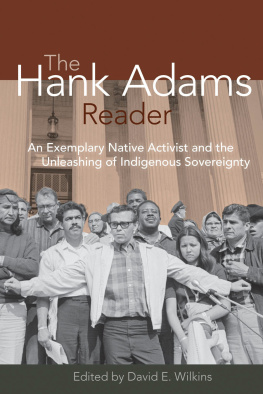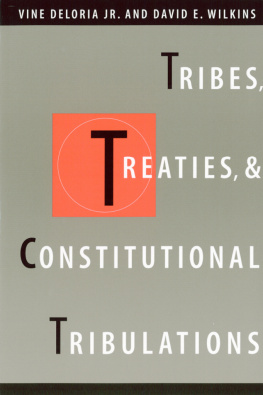Behind the Trail of Broken Treaties
Behind the Trail of Broken Treaties
AN INDIAN DECLARATION OF INDEPENDENCE
by Vine Deloria, Jr.

University of Texas Press,
Austin
International Standard Book Number 0-292-70754-1
Library of Congress Catalog Card Number 84-51686
Copyright 1974 by Vine Deloria, Jr.
Copyright 1985 by the University of Texas Press
All rights reserved
Printed in the United States of America
Eighth University of Texas Press printing, 2000
Requests for permission to reproduce material from this work should be sent to Permissions, University of Texas Press, Box 7819, Austin, Texas 78713-7819.
ISBN: 978-0-292-70754-2
ISBN: 978-0-292-75719-6 (e-book)
ISBN: 978-0-292-78946-3 (individual e-book)
Contents
Preface
The week of November 39, 1972, nearly a thousand American Indians in the caravan known as the Trail of Broken Treaties were in the nations capital to present Twenty Points which they had designed as a partial solution to the pressing problems of the American Indian community. The events of that desperate week overshadowed the real issues of the caravanwhich were highlighted in the Twenty Points and subsequent discussionbecause attention was focused on the destruction of some government records and partial damage to the headquarters of the Bureau of Indian Affairs.
During the negotiations between the people of the Trail of Broken Treaties and the people representing the administration, the people representing the federal government promised to consider the Twenty Points and to report back their responses within sixty days. On January 9th, 1973, a response to the Twenty Points was released from the White House under the signatures of Leonard Garment and Frank Carlucci. The response was hardly adequate to the issues raised.
Among the Twenty Points were several (points one, two, four, five, six, seven, and eight) which involved restoration of the authority to make treaties with Indian communities, with the need to enforce treaty provisions for the protection of Indian individuals and with the need to place all Indian people under a new general category of status to be known as treaty relations.
The treaty points were most strenuously rejected by members of the administration task force on the vague grounds that the Indian Citizenship Act of 1924 had precluded the United States from dealing with Indian tribes by treaty because the individual members thereof happened to be United States citizens.
The following is the administrations response to the first point of the Twenty Points, which involved a restoration of the constitutional authority to make treaties. This response generally characterizes the approach of the administration and seems to mean that the subject has been rejected without much consideration of the value of the proposal for contemporary times and in the context of the world situation today.
Over one hundred years ago the Congress decided that it was no longer appropriate for the United States to make treaties with Indian tribes. By 1924, all Indians were citizens of the United States and of the states in which they resided. The citizenship relationship with ones government and the treaty relationship are mutually exclusive; a government makes treaties with foreign nations, not with its own citizens. If renunciation of citizenship is implied here, or secession, these are wholly backward steps, inappropriate for a nation which is a Union.
Indians do need to represent their own interests, and Indian tribes, groups, and communities are finding increasingly effective ways of expressing these interests. There are several active and vocal nationwide Indian organizations; there are many tribal governments and these are being strengthened with full Administration support and endorsement. The President has even proposed that the administration and control of most BIA and HEW Indian programs be transferred to Indian tribal governments, at the latters option, but the Congress has not yet approved this legislative proposal.
The President has proposed the creation of an Indian Trust Counsel Authority to represent Indian interests in the vital field of natural resources rights, but the Congress has not enacted this legislation.
The White House and every Department in this Administration meets frequently with Indian leaders and groups, listens to and pays attention to Indian recommendations and, as for example in the development of the Alaska Native Claims legislation, works with Indian representatives on matters vitally affecting Indian people. We will continue to go forward with these many, close relationships.
It is singularly unfortunate that the authors of the White House response to the Twenty Points had such a lack of understanding of the history of the relationship between the United States and the aboriginal Indian tribes of the North American continent. Setting aside the early period of exploration by the European powers, and taking only the recent years of American history as a guideline, the policy of the United States with respect to the Indian tribes has been one of expediency grounded only in the political considerations of the moment and without any lasting understanding of the nature of peoples, laws, governments, or responsibilities.
The result of this has been a tremendous rise in federal expenditures with few visible results, the creation of numerous liabilities by the United States toward the Indian tribes with whom they have a relationship, hundreds of cases of needless litigation, and not one solid or concrete path by which either the United States or the Indian tribes can understand the nature of their relationship or find a way to conclude their business with each other on mutually satisfactory grounds.
This book does not make any pretense of being a final statement on the legal and moral issues involved in the present situation. It is written to demonstrate that the proposal to reopen the treaty-making procedure is far from a stupid or ill-considered proposal. Rather it is one which would place the United States in the forefront of civilized nations in its treatment of the aboriginal peoples of the continenta problem which even Japan and the Soviet Union have yet to solve. Moreover, by illuminating some of the twists and turns of the policies of the past, perhaps a better understanding of the status of the American Indian tribes can be seen in a world historical perspectivea perspective which the recent Vietnam war indicates is sadly lacking in contemporary American political understanding.
The responsibility of any nation, and the particular responsibility of elected officials of any nation, is not to justify what has passed for legality but to anticipate the conditions and problems of tomorrow and attempt to deal with them. The current confusion and violence in Indian country are a result of the failure to do so by generations of elected officials in this country. To continue to perpetuate myths about American Indians which have no basis in fact or in law is merely avoiding the larger issues confronting the nations of the world.
The concept of this book came into being in the context of the incident of Wounded Knee. Our plan was to present as fully as possible the background of ideas within which the declaration of independence of an Indian tribe would make sense. This has been a collective effort, for the most part, with many people thinking about the subject and several of us writing parts of the book. were written and researched primarily by Kirke Kickingbird and Fred Ragsdale, and were then given critical and incisive review by William Veeder.
VINE DELORIA, JR.
Behind the Trail of Broken Treaties
1. Preamble to the Present
Next page
![Deloria Jr. Behind the trail of broken treaties an Indian declaration of independence. [The goundbreaking work by the preeminent spokesperson for American Indian rights]](/uploads/posts/book/171989/thumbs/deloria-jr-behind-the-trail-of-broken-treaties.jpg)



